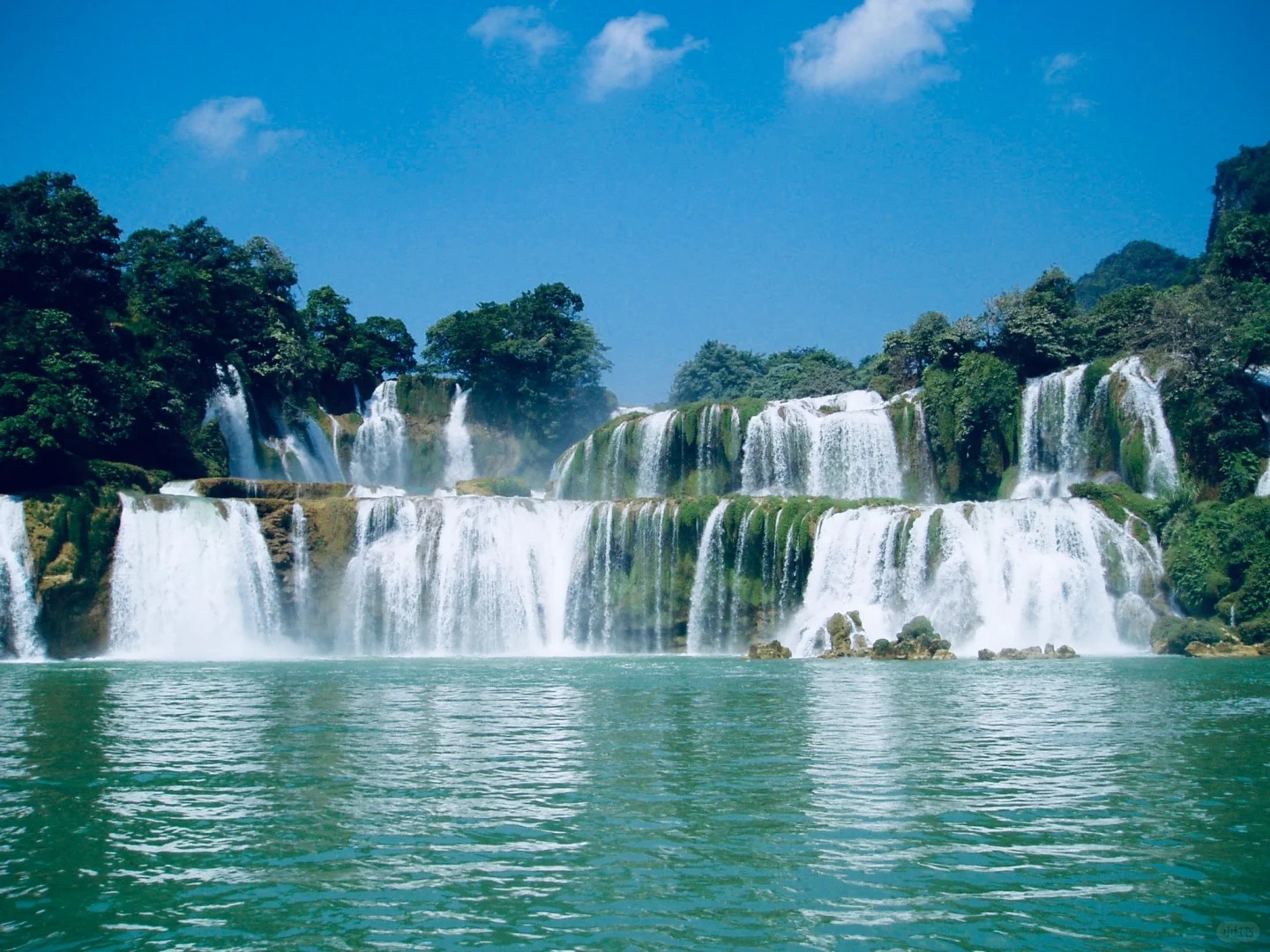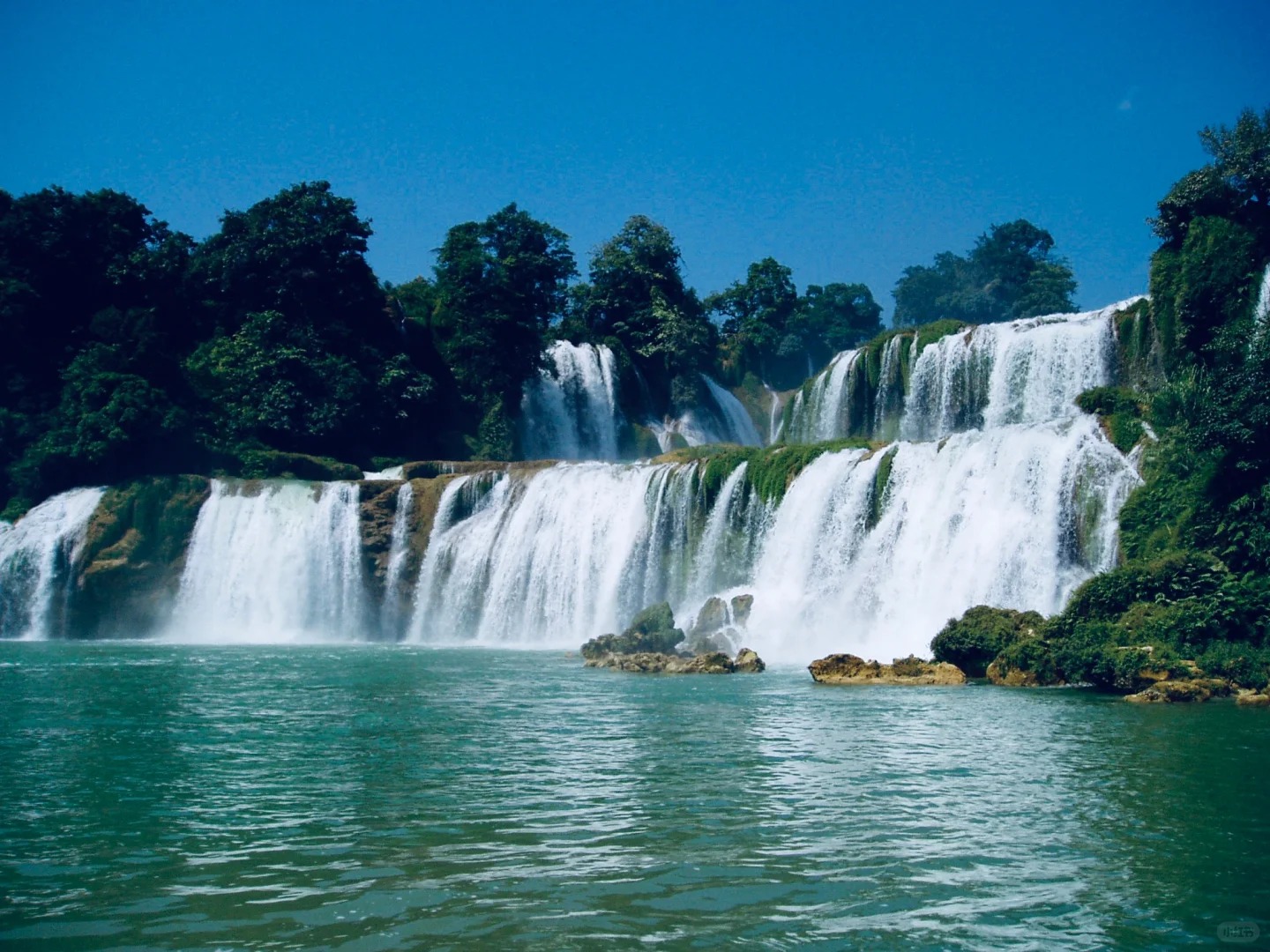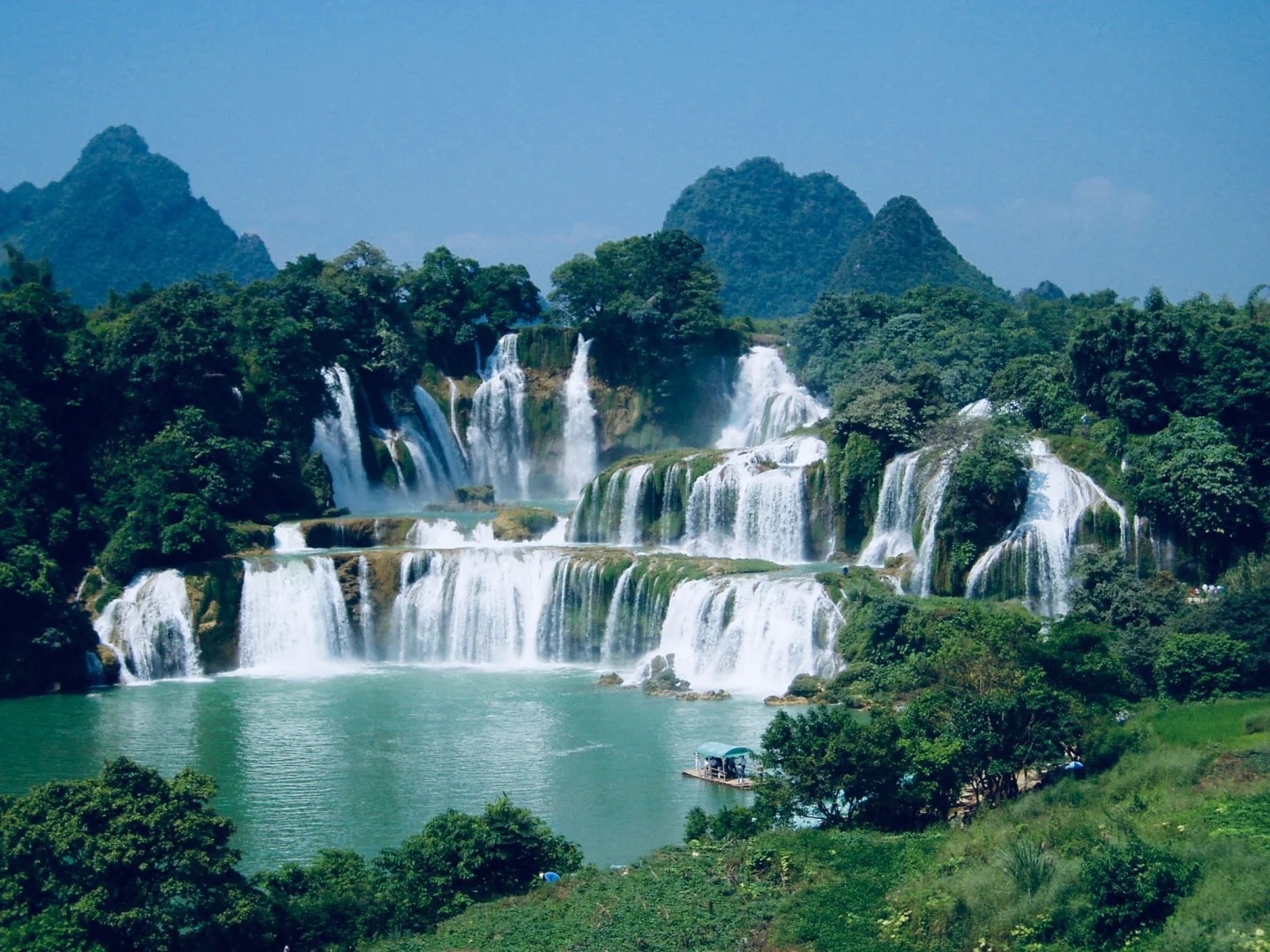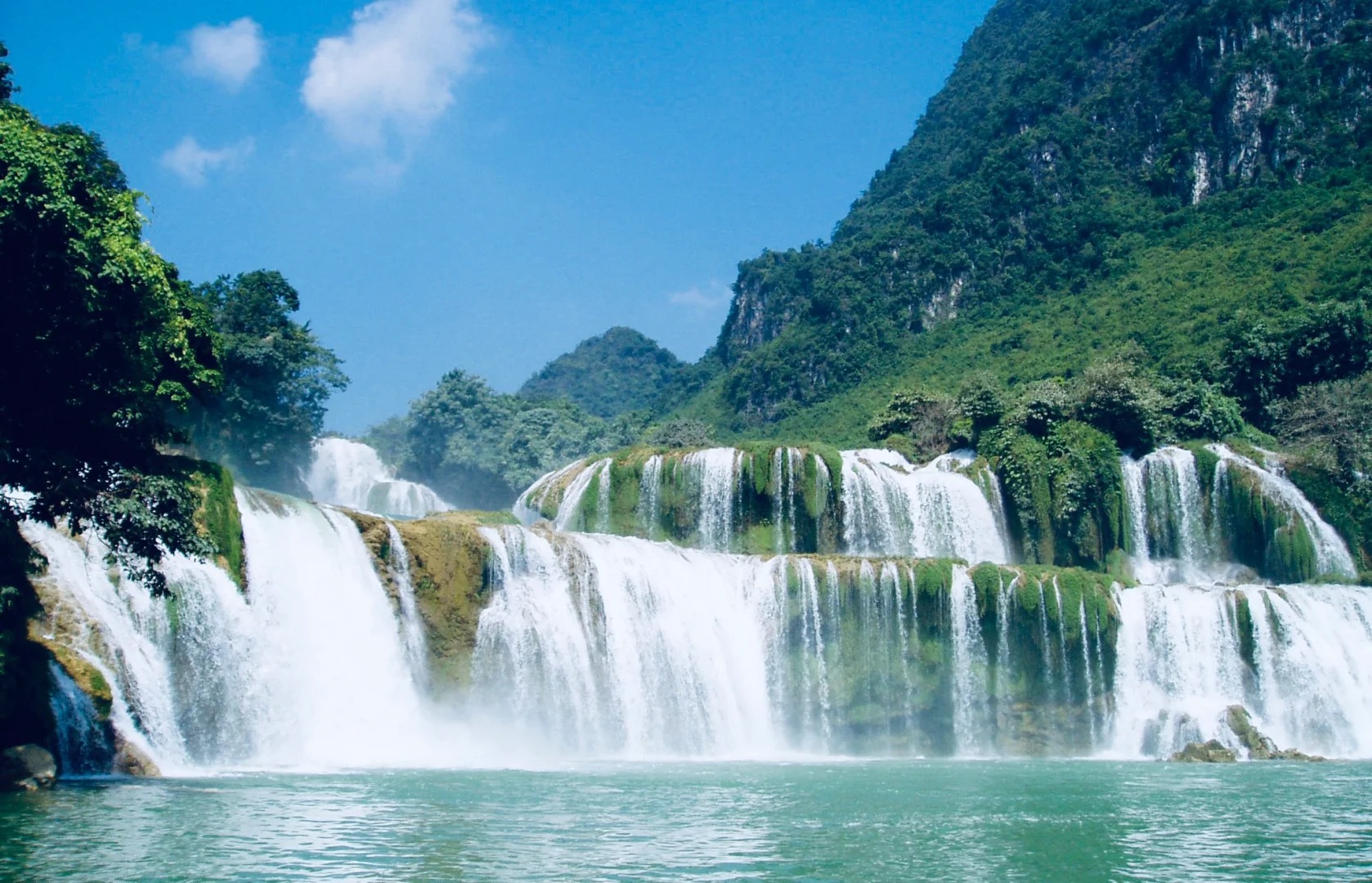Visiting Information
| Information | Details |
|---|---|
| Chinese Name | 德天瀑布 (Détiān Pùbù) |
| Location and Address | Daxin County, Chongzuo City, Guangxi Zhuang Autonomous Region, China |
| Opening Hours | 8:30 AM – 5:30 PM daily |
| Entrance Fee | 150 CNY (April to October); 130 CNY (November to March) |
| How to Get There | By Metro: Not available By Bus: Take a bus from Nanning to Daxin County, then a local bus to Detian By Taxi: Available from Nanning or Daxin County, but expensive |
| Best Time for Visit | May to September (rainy season for maximum water flow) |
| Contact Info | Phone: +86 771 7831133 |
Overview
Detian Waterfall, also known as Ban Gioc Waterfall in Vietnam, is a transnational waterfall on the border between China and Vietnam. It is the largest waterfall in Asia and the fourth largest transnational waterfall in the world. The waterfall is part of the Guichun River, which serves as a natural border between the two countries. Detian Waterfall is renowned for its breathtaking beauty, multi-level cascades, and lush surrounding landscape.
Historical Background
The history of Detian Waterfall is closely tied to the border relations between China and Vietnam. The area has been inhabited for thousands of years, with evidence of human activity dating back to prehistoric times. In more recent history, the waterfall has been a subject of border negotiations between the two countries. In 1999, China and Vietnam signed a border agreement that officially recognized the waterfall as a shared natural wonder, promoting cooperation in tourism development and environmental protection.

Architectural Features
- Multi-tiered Cascades: The waterfall features three main tiers, with the largest drop being about 70 meters high and 200 meters wide. The multi-level structure creates a spectacular scene of water cascading over limestone rocks.
- Karst Landscape: Detian Waterfall is set against a backdrop of karst mountains, characterized by limestone formations, caves, and sinkholes. This unique geological feature contributes to the waterfall’s stunning beauty.
- Viewing Platforms: Several man-made viewing platforms have been constructed to provide visitors with optimal vantage points to admire the waterfall. These platforms are designed to blend with the natural environment while offering safe and convenient viewing areas.
- Border Marker: A prominent border marker stands in the middle of the river, indicating the boundary between China and Vietnam. This unique feature adds to the international appeal of the waterfall.
Cultural Importance
Detian Waterfall holds significant cultural importance for both Chinese and Vietnamese people. It symbolizes the natural beauty and shared heritage of the border region. The waterfall has inspired local legends, art, and literature. It also plays a role in promoting cultural exchange and understanding between the two nations. The annual Detian Waterfall Festival, celebrated in April, showcases local traditions, music, and cuisine, attracting visitors from both countries and beyond.
Surrounding Attractions
- Tongling Grand Canyon: Located near Detian Waterfall, this canyon offers breathtaking views of karst landscape and clear streams. Visitors can explore the canyon through hiking trails and enjoy the pristine natural environment.
- Detian Ancient Town: This well-preserved town near the waterfall provides a glimpse into the traditional architecture and lifestyle of the region. Visitors can explore old streets, visit local markets, and experience the unique culture of the China-Vietnam border area.
- Shuolong Ethnic Village: This village showcases the culture and traditions of the Zhuang ethnic minority. Visitors can experience traditional performances, try local cuisine, and learn about Zhuang customs and crafts.

Photography Opportunities
- Panoramic Views: The main viewing platform offers stunning panoramic views of the entire waterfall complex. This spot is perfect for capturing the grandeur and scale of Detian Waterfall, especially during the rainy season when water flow is at its peak.
- Close-up Shots: Photographers can take a raft ride to get closer to the base of the waterfall, allowing for dramatic close-up shots of the cascading water and misty environment.
- Sunrise and Sunset: The waterfall takes on different characters throughout the day. Early morning and late afternoon offer soft, golden light that enhances the beauty of the scene and creates stunning reflections on the water.
- Cultural Photography: During festivals or on regular days, there are opportunities to capture images of local people in traditional dress, as well as scenes of daily life in the surrounding villages.
Modern Importance
- Tourism: Detian Waterfall has become a major tourist attraction, contributing significantly to the local economy. It attracts visitors from all over China, Vietnam, and internationally, promoting cultural exchange and boosting the hospitality industry in the region.
- Environmental Conservation: The waterfall and its surrounding ecosystem are important subjects of environmental conservation efforts. The site serves as a focal point for raising awareness about the importance of preserving natural habitats and water resources.
- International Cooperation: As a transnational natural wonder, Detian Waterfall serves as a symbol of cooperation between China and Vietnam. It has fostered joint efforts in tourism development, border management, and environmental protection.
- Scientific Research: The unique geological features and biodiversity of the area make it an important site for scientific research, particularly in the fields of geology, hydrology, and ecology.

FAQ
- What is Detian Waterfall famous for?
Detian Waterfall is famous for being the largest waterfall in Asia and the fourth largest transnational waterfall in the world. It’s known for its multi-tiered cascades, stunning natural beauty, and unique location on the China-Vietnam border. - What’s inside Detian Waterfall?
Detian Waterfall consists of multiple tiers of cascading water, surrounded by lush karst mountains. Visitors can explore viewing platforms, take raft rides, and enjoy the scenic landscape including caves and pools formed by the waterfall. - Is Detian Waterfall free?
No, Detian Waterfall is not free. There is an entrance fee that varies depending on the season: 150 CNY from April to October, and 130 CNY from November to March. - Is Detian Waterfall worth visiting?
Yes, Detian Waterfall is definitely worth visiting. Its spectacular beauty, unique transnational status, and surrounding natural landscape make it a must-see attraction for nature lovers and photographers. - What to do in Detian Waterfall?
At Detian Waterfall, you can enjoy the views from various platforms, take a raft ride to get closer to the falls, explore nearby caves, hike in the surrounding area, visit the border marker, and experience local culture in nearby villages. - How do I get to Detian Waterfall in the local city?
From Nanning, the capital city of Guangxi, you can take a long-distance bus to Daxin County, which takes about 3-4 hours. From Daxin, you can then take a local bus or hire a taxi to reach Detian Waterfall, which is about 40 km away. - How to visit Detian Waterfall?
To visit Detian Waterfall, it’s best to plan a full day trip. Wear comfortable shoes for walking, bring water and snacks. Consider joining a guided tour for convenience. The best time to visit is during the rainy season (May to September) for maximum water flow. Remember to bring your passport if you plan to cross to the Vietnam side.



